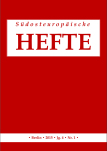
Janusz Korczak - dziecko i Bóg
Nell’anno 2002 passa sessant’anni dalla morte di Janusz Korczak (1879–1942). Nonostante del tempo si nota il continuo interesse del pensiero e del sistema educativo di Janusz Korczak, uno dei piu’ significativi educatori in Polonia del periodo 1918–1939. L’idea del bambino nel pensiero di Korczak e’ molta chiara e non fa nessun problema, invece la questione della sua religione fa molti problemi. Per alcuni Korczak era ateista, per altri non credente. Ci sono pero’ le opinioni che mettono Korczak e il suo comportamento religioso da parte del misticismo. L’articolo presente cerca di rispondere ai sopraddetti argomenti basando sui testi dell’Autore. Il bambino era per Lui un mistero di Dio e una cosa santa. Al riguardo della religione si puo’ constatare che Korczak ha sovrapassato la religione ebraica e la fede cattolica.
More...




